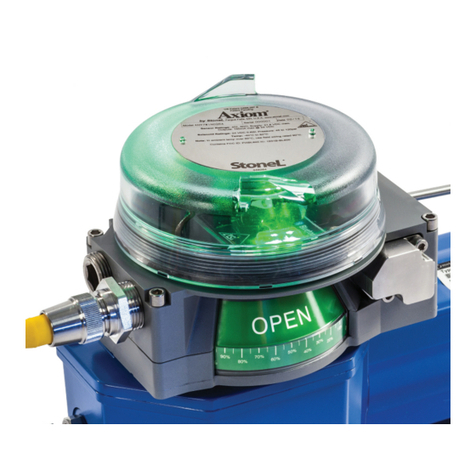
7 PI 70 en10 | Prism PI
StoneL publication 105431revC
4 Function specic details
4.1 Sensor/switching modules
4.1.1 SST NO sensor (33S)
Common receptacle options pin-out
Signal
OPEN NO
4-PIN MICRO CONNECTOR (M12)
CLOSED NO
CLOSED C
OPEN C
Pin
1
2
3
4
MALE (PINS)
1 2
43
With solenoid
No solenoid
CLOSED C
MALE (PINS)
MALE (PINS)
1
1
2
2
5
5
4
4
3
3
5-PIN MICRO CONNECTOR (M12)
5-PIN MINI CONNECTOR
CLOSED NO
not used
OPEN NO
OPEN C
Pin
1
2
3
4
5
OPEN/CLOSED C
CLOSED NO
OPEN NO
SOL PWR 2
SOL PWR 1
Pin
1
2
3
4
5
Caution: A series load resistor must be used when
bench testing in order to ensure proper module operation.
Caution: Performing this procedure will cause the sensor
inputs to change states. Performing this procedure is not
recommended during a live process.
Bench test procedure and sensor setting instructions
Power must be applied to both sensors to ensure proper circuit
operation. Use a 24VDC power supply with series load resistor, (2K -
6K Ω), connected to the 24VDC+.
1. Connect 24VDC+ to the CLOSED C (common) and OPEN C
(common) terminals. Connect 24VDC- to the CLOSED NO and
OPEN NO terminals.
2. Operate actuator to the closed position.
3. Press and hold SET CLOSED button until the red LED is lit
(2seconds). Release button.
4. Operate actuator to the open position.
5. Press and hold SET OPEN button until the green LED is lit
(2seconds). Release button.
6. Setpoints are retained even after power is removed.
To electrically test solenoid, apply power to the SOL PWR 1 and SOL
PWR 2 terminals only.
Note
If using only one of the sensors for valve position feedback, the closed
sensor (red) must be used.
Expanded dead band setting feature
The Prism PI sensing module has the capability of changing the dead
band of the open sensor from the factory setting of 30% of stroke
to an expanded setting of 45%. It may be necessary to perform this
procedure for applications in which the valve stroke varies between
normal batch processing and SIP/CIP evolutions.
1. Ensure the open and closed sensors have been set before running
this procedure. Valve can be in either the open or closed position.
2. With power applied to the Sensing Module press and hold both
SET OPEN and SET CLOSED buttons until the red and green LEDs
ash (ve seconds). Release buttons.
3. Press and hold SET OPEN button until the green LED is lit (one
second). Release button. Open sensor now has a 45% dead band.
4. To revert back to the factory default of 30% dead band, press and
hold both SET OPEN and SET CLOSED buttons until the red and
green LEDs ash (ve seconds). Release buttons.
5. Press and hold SET CLOSED button until red LED is lit (one second).
Release button.
6. Settings are retained even after power is removed.
Wiring diagrams
Set Open
Set Closed
Valve
Open LED
Solenoid
power LED
Y
G
Valve
Closed LED
R
PWR
2
1
SOL OPEN CLOSEDSOL
1
NO
C CNO
2
Specications
Conguration (2) N.O. 2-wire solid state sensors
Voltage range 20 - 125 VAC 50/60 Hz; 20 - 125 VDC
Minimum on current 2.0 mA
Maximum continuous current 0.1 amps
Maximum leakage current 0.5 mA
Maximum voltage drop 6.5 volts @ 10 mA
7.0 volts @ 100 mA
Circuit protection Protected against short circuits and direct
application of voltage with no load.




























